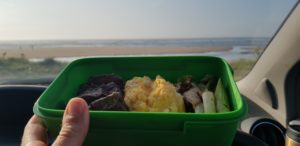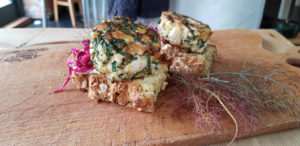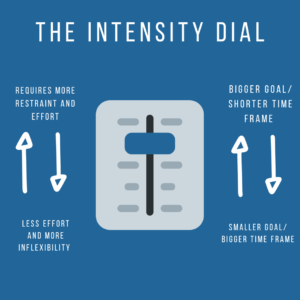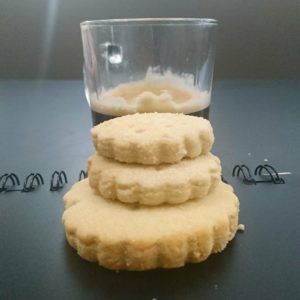Making Nutrition Work For You
“A lot of people know this feeling. The feeling that you are trying really hard, getting results, but you just can’t wait to go back to eating how you were before. Then, when you get there and start eating the same way you used to, your results slowly begin to slip away”

The repetitive cycle of on and off ‘dieting’.
I know this personally too. I’d go at it for a few weeks, realise I’m working my ass off and it’s mentally as well as physically fatiguing to try and keep it up. What we all really want is just to be able to manage our food, without really thinking that hard about it.
Here’s the kicker though, you have to do the latter before you can have the former. BUT, probably not in the way you’re thinking.
Long term behaviour change certainly doesn’t happen overnight. It takes practice, mistakes and reflection to make the things that are worthwhile for your mental and physical health as well as your appearance to stick. Nutrition, much like training, is a long game. The longer you play, the more potential you have to learn and dial it in to a lifestyle that is built to serve you well.
I’d like to first quantify what I mean here by making nutrition ‘work’ for you. I got this as a question on Instagram and interpreted it as how to achieve what you want with your goals without feeling like nutrition is taking up all of your free headspace.
What I will cover is the following: why intuitive eating is great but maybe just not right now, why it is worth being more regimented for a short time to make long term progress, where to begin with nutrition, identifying hunger signals vs. appetite signals, changing your approach over the long term and how this is all really just a game.
But this doesn’t come without work.
There has been a big move towards eating intuitively in the fitness industry recently, which like everything has positives and drawbacks. On the one hand, it is a much less time consuming way to go about your day if you are just eating till you are full and only when you are hungry. The problem is, a lot of people don’t know to (warning, these may be a few hard to swallow truth bullets): identify how much they are eating, how to eat for their goals, when they are truly hungry, how to identify when they are full, how to slow down and enjoy food, how to enjoy food guilt free and how to manage intake and food choices to fit their lifestyle AND their goals.
In short, for a lot of people they cannot simply eat intuitively because they don’t have the education to make those decisions yet. That isn’t a judgement, just a fact. You wouldn’t try and fix a car engine if you’d only ever changed the oil now would you?
Before I go any further, I would like to just reiterate something. I cannot provide a catch-all magic solution here. It would be dishonest and irresponsible to say such a thing exists. There are, however, some general principles that everyone can look at and use to their advantage.

Work First, Reap Rewards Later
I think there is a lot of value in using a tool or method which requires a bit more work, but gives you more accuracy in the measurement. A lot of people push tracking to one side as obsessive or too much of a hassle…if you frame it that way of course it is going to seem like that, because that is only the potential negative side of it. What about the ability to understand and manage what you are eating on a day to day, week to week basis and achieve the goals you want at the same time as enjoying your favourite foods every now and again?
That being said, tracking isn’t the only way you can manage portions. However, it is more accurate than guessing by eyeballing it if you are struggling to make progress right now.
Personally, I think being a bit more regimented with your food gets demonised a lot more than it should. It can be a hugely liberating thing to do if you approach it with the right mindset. That is, that most of your food will come from whole, nutritious sources but with a little room for pure enjoyment. In short, if you are willing to track everything you eat for a set amount of time you can learn a lot from it. We’ll talk about this more in the next section…

Where to begin?
Now, although tracking your food isn’t the only way to do things I do think it has a lot more benefits than drawbacks. I’ve heard lots of people say they are too busy to weigh and track their food, but I only think that is the case because it has been framed in such a way. It doesn’t have to be a laborious task and can infect become very quick once you get over the initial learning curve (although, this is a blog post in its own right to go over the ways you could simplify the proccess!)
I would recommend starting with a calorie target and a protein target. To start with for everyone that is usually enough to begin with before considering particular fat or carbohydrate targets. They can impact performance, but with regards to body composition unless you are near enough photo shoot lean your split between fats and carbs comes down to preference over anything.
Here is a quick cheat sheet you can use to get started:
Bodyweight in lbs = kg x2.2
Fat Loss bw (lbs) x10-14 – start at 14 and if measurements/pictures show no fat loss drop x1 (so from 14 to 13) after 10-14 days, repeat same process until you start seeing consistent fat loss but go no lower than 10. If you aren’t seeing progress there it is unlikely a calorie issue and more likely under-reporting food either knowingly or unknowingly.
Maintenance bw (lbs) x14-16 – Start at 14 and work up if you are losing body fat there, measured by measurements and pictures.
Muscle Gain bw (lbs) x16-22 – Start at 16 and work up. You want to see minimal fat gain (some is to be expected!) so take your time. The closer you are to a beginner the higher you can go above maintenance, but even then it’s likely around 500 calories surplus. For more intermediate it’s more likely 200-300 and advanced 100-200 calories surplus.
Protein target regardless of goal bw (lbs) x1.6-2.2 – Somewhere between that range is fine for most. Generally if you want to achieve fat loss going on the higher end may well help with staying fuller for longer and potentially preserving muscle mass a little more and if you want to gain weight you might want to go on the lower end to make room for easier calories from carbs and fats!
I would also recommend allocating a ‘flexibility allowance’ for foods you simply enjoy if you feel the need to. I’ve spoken to a lot of people who are making progress in their training and body composition and yet still feel guilty for eating foods like chocolate bars or cookies or pizza. What I suggest is allocating 10-20% of your calories for simply food you enjoy. Enjoy it, track it, move on and relax. I’ve found it’s a great way to develop a better relationship with food you enjoy without feeling like it needs to impact on your goals. If you have more calories to play with, go for the higher end and likewise if you have lower calories it’s probably a sensible idea to go for the lower end to make sure you can stay fuller from eating plenty of whole foods!

Hungry? Really?
Hunger can be a tricky beast to interpret. The reason being it can be tricky to tell if it is hunger or appetite that is getting you excited for that thing you really want to eat right now. You know, that one piece of food that has been on your mind all day? Just think about it really hard for a second. How does it smell? Good right? How does it look? What are the flavours like? What would the first bite be like?
Now, if you are anything like me, you’re mouth will be watering at the thought of doughnuts from proven goods (if you live in Newcastle and haven’t been there, you haven’t lived). This is a classic example of appetite over hunger. What we sometimes interpret as hunger can be something that has just got us excited to eat something. That could be smell, sight, sound, emotions or even thoughts.
Ask yourself when the last time you really felt your belly rumble was. If it hasn’t been for a long time, I challenge you to wait until you feel that again before you next eat to just remember what it feels like. When you get a sensation of wanting to eat something, set a timer for 5 minutes. If you get to the end and your belly isn’t rumbling, set another 5 minutes and repeat until your belly rumbles.
When we are actually hungry too, we can rush through food without really appreciating it properly. Something that precision nutrition do a great job of promoting is taking your time to eat and stopping when you are 80% full. Although this is a little more subjective to measure, it’s worth practicing as a mindfulness task next time you have a meal.
Instead of sitting down, distracted, in front of the t.v…try switching it off, sitting at the table and taking at least 20 minutes to enjoy your food. Personally, I really struggled with this to begin with but it does make a difference in how full you feel by actually giving your food time to digest properly!

The Intensity Dial
The way I talk about this with my personal training clients is like an intensity dial. The bigger the goal and the faster you want to get there, the higher the intensity is going to have to go and the more you will have to tolerate.
The intensity changes, but the methods may not.
Let me explain. Lets take portion control for our example here. If you want to lose body fat, you will likely be practicing a different kind of portion control compared to trying to gain muscle mass. The skill in itself is not ‘fat loss portion control’ but portion control itself and knowing how to manipulate it to consume either less or more.
Once you have reached a goal, maintaining it takes the same skill set just used in a slightly different manner. There is still portion control, but with a bit more flexibility to do things like eat out. The way this usually gets interpreted and the way that tends to end up in big rebounds after achieving a goal is: ‘I’ll use this to get there, then just do whatever I want when I arrive’.
Nobody is judging for that attitude, but it’s not going to help maintain results. Instead, what you could do is think of it like allowing degrees of more or less rigidity and flexibility with some common themes: low calorie/high calorie foods, extra/fewer snacks, plate filled with more carbs&fats vs plate filled with more veggies, swap outs for low fat, swap outs for full fat etc.
Once you’ve achieved a result, your mindset towards maintaining that is as important as it was to getting there. All we are trying to do is turn the intensity dial back down a little, but not so much we don’t have any at all.
(I’ve written about this in another blog post: https://jackedpersonaltraining.co.uk/understanding-the-effort-needed-for-any-goal/)

It’s all just a game in the end.
I’m a massive game nerd. I’m not even half good at most of them, but there is a lot of satisfaction in the sensation of levelling up and being able to coast through most of the game past a certain point, only deploying your harder to pull off skills when it really matters.
We can think about food in the same way. I bought a game called Horizon Zero Dawn and for anyone that’s played it they’ll know its bloody hard for the first half of the game pretty much. There is no getting around the learning curve other than just being patient and practicing the skills you pick up. It takes some time to become better at the game but once you start getting there, you pick up steam and things move a lot faster until…BOOM…you’ve just defeated the final boss and you can coast around the game .
When you first start trying to make changes and implement new habits, it is much like a video game. You have to start at level 1 first and learn the basics before you get on to that fancy new weapon you saw on that YouTube video…not that this is something I do at all…
My point here is it’s all a learning game. Making food work for you takes time and effort, especially at the start. You’ll likely have to think about it more at the beginning and less as you go along and it becomes more intuitive. But, put the effort in at the start and it’ll pay off big time in the long run when you can do things on autopilot.
